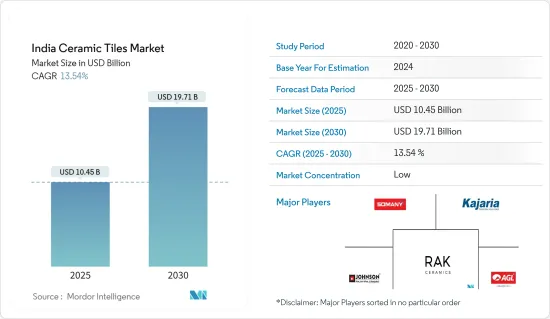
|
시장보고서
상품코드
1687855
인도의 세라믹 타일 시장 : 시장 점유율 분석, 산업 동향 및 통계, 성장 예측(2025-2030년)India Ceramic Tiles - Market Share Analysis, Industry Trends & Statistics, Growth Forecasts (2025 - 2030) |
||||||
인도의 세라믹 타일 시장 규모는 2025년에 104억 5,000만 달러로 추정되고, 예측 기간인 2025-2030년 CAGR 13.54%로 성장할 전망이며, 2030년에는 197억 1,000만 달러에 달할 것으로 예측되고 있습니다.

최근 인도의 세라믹 타일 시장은 꾸준히 성장하고 있습니다. 코로나 바이러스의 유행으로 인한 봉쇄로 약 1,000만 명의 이민 노동자가 모국으로 귀국했습니다. 이 노동력 부족으로 인해 세라믹 타일 제조업체는 시급한 프로젝트를 완성할 수밖에 없었습니다. 인도의 세라믹 타일 수요 증가는 몇 가지 요인에 기인하고 있습니다. 정부의 시책에 의해 부동산 분야가 급성장하고 있으며, 주택 분야도 강력한 성장세를 나타내고 있습니다. 인도의 가처분 소득도 증가하고 있어 사람들은 생활이나 일터를 아름답게 하는 방법을 찾고 있습니다. RERA에 의해 부동산업은 보다 투명화되고 프로세스 중시가 되었습니다. 욕실 용품이나 무균 타일에서는 터치리스나 위생 지향의 신제품에 대한 수요가 가까운 장래에 시장의 최전선에 설 가능성이 있습니다. 몇몇 정부 계획이 인도 부동산 시장을 뒷받침할 것 같습니다.
RERA도 세라믹 산업에 직접적인 영향을 미칩니다. 향후 수년간 인도의 주택용 세라믹 타일 시장 부문에서는 리모델링 움직임이 활발해질 것으로 예상됩니다. 사람들은 벽과 바닥을 업그레이드하기 위해 막대한 금액을 쓰고 있습니다. 이는 향후 수년간 주택 시장 주택 부문에서 세라믹 제품 수요를 촉진하는 중요한 요인 중 하나가 될 것으로 생각됩니다.
인도의 세라믹 타일 시장 동향
도시화 진전이 시장을 견인
인도에서는 급속한 도시화가 진행되고 있어 올해도 도시 인구가 인구의 상당한 비율을 차지하고 있습니다. 인도의 도시화 급증은 주로 도시 확대 및 대규모 이주에 의한 것입니다. 이 나라는, 주택, 도로망, 도시 교통, 물 공급, 전력 인프라, 스마트 시티, 도시 관리 구상 등, 다양한 도시 부문에 투자를 실시해 왔습니다. 이러한 도시화의 물결은 주택 및 상업 건축 시장의 수요에 박차를 가해 인도의 세라믹 타일 부문의 성장을 뒷받침하고 있습니다. 인도의 도시 인구는 급증하는 중산층 및 안정적인 민주주의에 힘입어 절대적인 성장을 이루고 있을 뿐만 아니라 이주자 유입도 끊이지 않아 새로운 도시의 출현으로 이어질 가능성도 있습니다.
인도의 부동산 투자 증가로 시장 견인
경제 위기에도 불구하고 부동산 투자는 수익성을 유지하고 항상 긍정적인 수익을 창출하고 있습니다. 이 투자 급증은 인도의 주택 수요 증가에 박차를 가해 이 나라 총 기와 수요의 70%를 차지하고 있습니다. 부동산 투자 신탁(REIT)은 부동산 분야에 대한 투자 기회를 넓혀 기관투자가 및 개인투자가 모두를 매료시키고 있습니다. 리츠는 부동산을 소유하지 않고 부동산에 투자할 수 있다는 매력적인 제안을 하고 있어 분산투자를 지향하는 투자자들에게는 특히 매력적입니다. 게다가 인도 중산층의 가처분 소득이 급증하고 있는 것도 개발업자나 투자가가 이 신흥국 시장에 참가하는 계기가 되고 있습니다.
인도의 세라믹 타일 시장 개요
이 보고서는 세분화된 인도의 세라믹 타일 시장에서 주요 세계 진출 기업에 초점을 맞추었습니다. 현재 소수의 대기업이 큰 시장 점유율을 차지하고 있습니다. 그러나, 기술의 진보나 제품의 진화에 수반해, 중견 및 중소기업이 그 세력을 확대하고 있습니다. 그들은 새로운 계약을 획득하고 미개척 시장을 개척함으로써 이를 실현하고 있습니다.
기타 혜택
- 엑셀 형식 시장 예측(ME) 시트
- 3개월간의 애널리스트 서포트
목차
제1장 서론
- 조사의 전제조건 및 시장 정의
- 조사 범위
제2장 조사 방법
제3장 주요 요약
제4장 시장 인사이트 및 역학
- 시장 개요
- 시장 성장 촉진요인
- 시장을 활기차게 하는 부동산 부문
- 라이프 스타일 변화 및 가처분 소득 증가가 시장 성장 뒷받침
- 시장 성장 억제요인
- 원료의 고비용
- 숙련 노동자의 부족
- 시장 기회
- 기술 진보가 분야 견인
- Porter's Five Forces 분석
- 구매자 및 소비자의 협상력
- 공급기업의 협상력
- 신규 참가업체의 위협
- 대체품의 위협
- 경쟁 기업간 경쟁 관계의 강도
- 산업 공급망 및 밸류체인 분석
- 시장의 최근 동향에 대한 인사이트
- 시장의 기술 동향에 관한 인사이트
- 시장에 대한 COVID-19의 영향(포스트 COVID-19 및 프리 COVID-19)
제5장 시장 세분화
- 제품별
- 유약
- 도자기
- 스크래치 프리
- 기타
- 용도별
- 바닥 타일
- 벽 타일
- 기타
- 건축 유형별
- 신축
- 교체 및 리폼
- 최종 사용자별
- 주택용
- 상업
제6장 경쟁 구도
- 시장 집중 개요
- 기업 프로파일
- Asian Granito India Limited
- Kajaria Ceramics Limited
- Nitco Limited
- Orient Bell Limited
- Varmora Granito Private Limited
- RAK Ceramics
- Somany Ceramics Limited
- Murudeshwar Ceramics Limited
- H & R Johnson(India) Limited(Prism Johnson)
- Simpolo Vitrified Private Limited*
제7장 시장의 미래
제8장 면책사항
AJY 25.05.07The India Ceramic Tiles Market size is estimated at USD 10.45 billion in 2025, and is expected to reach USD 19.71 billion by 2030, at a CAGR of 13.54% during the forecast period (2025-2030).

In recent years, the Indian ceramic tiles market has been growing steadily. Due to the lockdown due to the coronavirus outbreak, around 10 million immigrant workers returned to their home country. This shortage of labor forced ceramic tile manufacturers to complete projects promptly. The increasing demand for ceramic tiles in India can be attributed to several factors. The real estate sector is growing rapidly due to government policies, and the housing sector is also seeing strong growth. The disposable income of India is also increasing, and people are looking for ways to beautify their living and workspaces. RERA has made the real estate industry more transparent and process-oriented. The demand for new touchless or hygiene-oriented products in bathroom ware and germ-free tiles may be at the forefront of the market in the near future. Several government schemes are likely to boost the Indian real estate market.
RERA also has a direct impact on the ceramic industry. Over the next few years, remodeling activity is expected to increase in India's residential ceramic tiles market segment. People are spending huge amounts of money to upgrade their walls and flooring. This will be one of the key factors driving demand for ceramic products in the residential segment of the residential market over the next few years.
India Ceramic Tiles Market Trends
Growing Urbanization is Driving the Market
India has witnessed rapid urbanization, with the urban population accounting for a significant share of the population in the current year. The surge in urbanization in India is primarily attributed to city expansions and significant migration. The country has channeled investments into various urban sectors, including housing, road networks, urban transport, water supply, power infrastructure, smart cities, and urban management initiatives. This urbanization wave has notably spurred demand in residential and commercial construction markets, propelling growth in the Indian ceramic tiles sector. India's urban population is not only witnessing absolute growth, buoyed by a burgeoning middle class and a stable democracy, but also witnessing a consistent influx of migrants, potentially leading to the emergence of new cities.
Rising Investments in Real Estate in India is Driving the Market
Despite the economic crash, real estate investments have maintained their reputation for profitability, consistently yielding positive returns. This investment surge has correspondingly fueled a heightened demand for housing in India, which accounts for 70% of the country's total tile demand. Real Estate Investment Trusts (REITs) have broadened investment opportunities in the real estate sector, luring in both institutional and retail investors. REITs offer an enticing proposition: the chance to invest in real estate sans property ownership, making them particularly appealing to diversification-minded investors. Moreover, the burgeoning disposable income of India's middle class has enticed developers and investors to tap into this expanding market.
India Ceramic Tiles Market Overview
The report focuses on key global players in India's fragmented ceramic tiles market. Presently, a handful of major players hold significant market shares. Yet, as technology advances and products evolve, mid-sized and smaller firms expand their footprints. They achieve this by securing fresh contracts and exploring untapped markets.
Additional Benefits:
- The market estimate (ME) sheet in Excel format
- 3 months of analyst support
TABLE OF CONTENTS
1 INTRODUCTION
- 1.1 Study Assumptions and Market Definition
- 1.2 Scope of the Study
2 RESEARCH METHODOLOGY
3 EXECUTIVE SUMMARY
4 MARKET INSIGHTS AND DYNAMICS
- 4.1 Market Overview
- 4.2 Market Drivers
- 4.2.1 Real Estate Sector Booming the Market
- 4.2.2 Changing Lifestyles and Rising Disposable Incomes Helping Growth of the Market
- 4.3 Market Restraints
- 4.3.1 High Cost of the Raw Material
- 4.3.2 Lack of Skilled Labour
- 4.4 Market Opportunities
- 4.4.1 Technological Advancement Driving the Sector
- 4.5 Porter's Five Forces Analysis
- 4.5.1 Bargaining Power of Buyers/Consumers
- 4.5.2 Bargaining Power of Suppliers
- 4.5.3 Threat of New Entrants
- 4.5.4 Threat of Substitute Products
- 4.5.5 Intensity of Competitive Rivalry
- 4.6 Industry Supply Chain/Value Chain Analysis
- 4.7 Insights on Recent Developments on the Market
- 4.8 Insights on Technological Trends in the Market
- 4.9 Impact of COVID-19 on the Market (Post and Pre-COVID-19)
5 MARKET SEGMENTATION
- 5.1 Product
- 5.1.1 Glazed
- 5.1.2 Porcelain
- 5.1.3 Scratch Free
- 5.1.4 Other Products
- 5.2 Application
- 5.2.1 Floor Tiles
- 5.2.2 Wall Tiles
- 5.2.3 Other Applications
- 5.3 Construction Type
- 5.3.1 New Construction
- 5.3.2 Replacement and Renovation
- 5.4 End-User
- 5.4.1 Residential
- 5.4.2 Commercial
6 COMPETITIVE LANDSCAPE
- 6.1 Market Concentration Overview
- 6.2 Company Profiles
- 6.2.1 Asian Granito India Limited
- 6.2.2 Kajaria Ceramics Limited
- 6.2.3 Nitco Limited
- 6.2.4 Orient Bell Limited
- 6.2.5 Varmora Granito Private Limited
- 6.2.6 RAK Ceramics
- 6.2.7 Somany Ceramics Limited
- 6.2.8 Murudeshwar Ceramics Limited
- 6.2.9 H & R Johnson (India) Limited (Prism Johnson)
- 6.2.10 Simpolo Vitrified Private Limited*



















